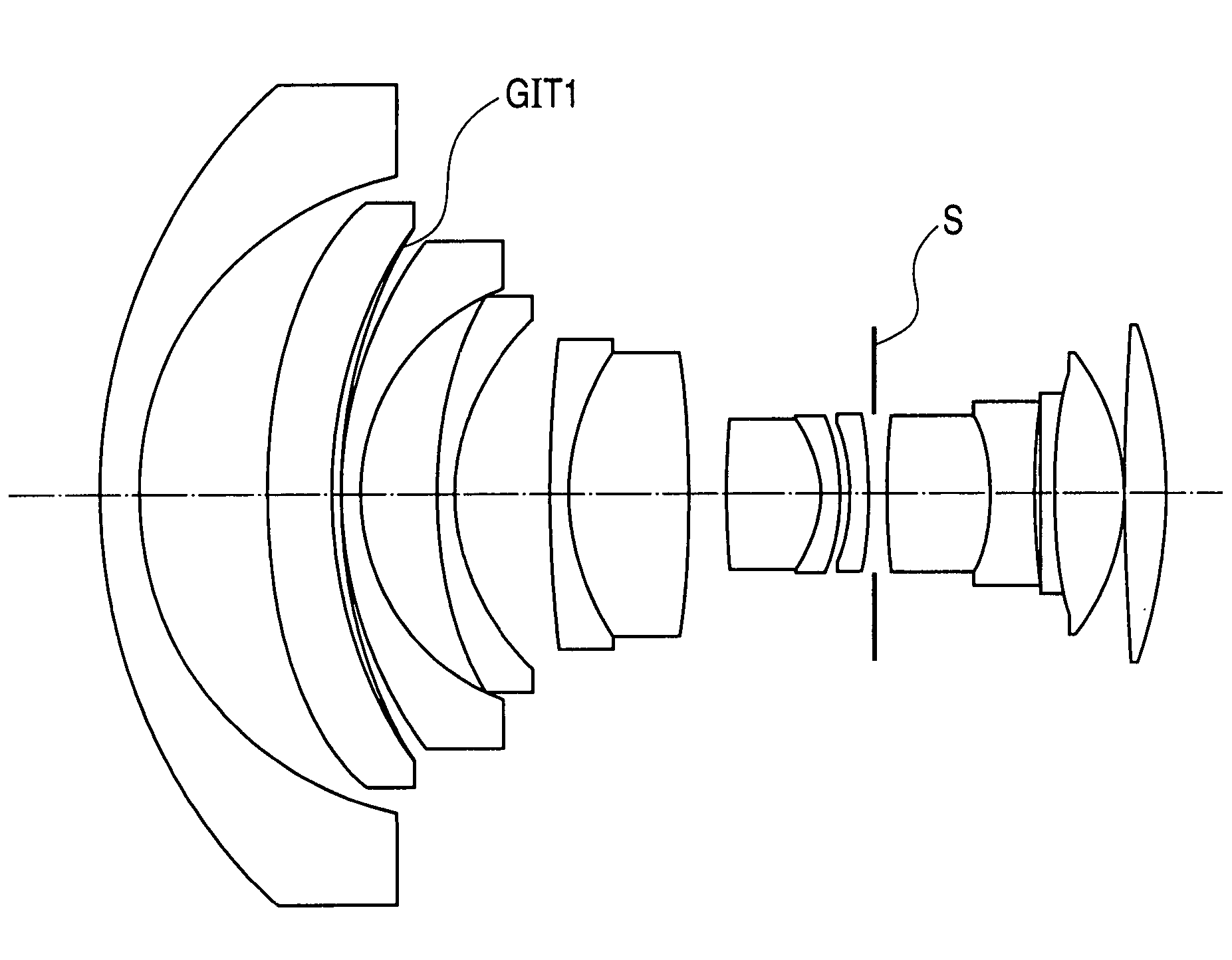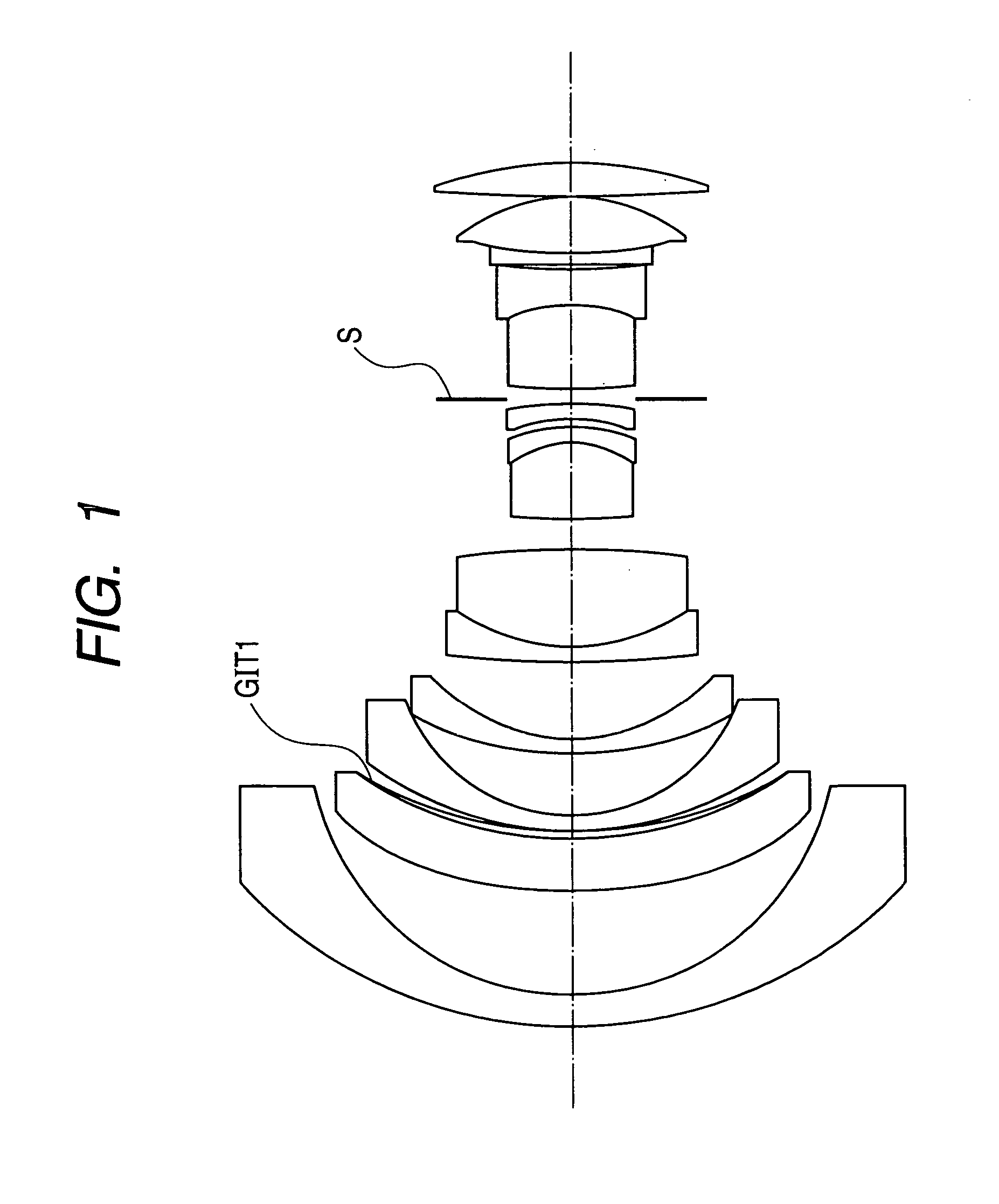Retrofocus type optical system
a technology of optical system and retrofocus, which is applied in the field of optical system, can solve the problems of chromatic aberration, chromatic aberration, and chromatic aberration, and achieve the effects of excellent environmental tolerance, favorable correction of various aberrations, and easy manufacturing
- Summary
- Abstract
- Description
- Claims
- Application Information
AI Technical Summary
Benefits of technology
Problems solved by technology
Method used
Image
Examples
embodiment 1
[0090] In the optical system of numerical embodiment 1, the lens (layer) made of the mixture containing ITO fine particles is employed in the object side portion, in which the height, from the optical axis, of the path of the paraxial chief ray is relatively high. In addition, the lens (layer) GIT1 made of the mixture containing ITO fine particles is designed to have a positive refractive power to mainly correct chromatic aberration of magnification, so that a retrofocus type optical system in which chromatic aberration of magnification is excellently corrected is realized.
[0091]FIG. 3 is a cross sectional view showing an optical system according to numerical embodiment 2, in which a lens (or layer) made of a mixture containing ITO fine particles is employed in a wide angle zoom lens with the focal length range of 17 mm to 40 mm. In this example, acrylic in which ITO fine particles are mixed at a proportion of 20% is used. In FIG. 3, reference sign GIT2 designates the lens (layer) m...
embodiment 2
[0092] In the optical system of numerical embodiment 2, the lens (layer) made of the mixture containing ITO fine particles is employed on the image side of the aperture stop S, in which the height, from the optical axis, of the path of the paraxial chief ray is relatively high. In addition, the lens (layer) GIT2 made of the mixture containing ITO fine particles is designed to have a negative refractive power to intensively correct chromatic aberration of magnification, so that a retrofocus type optical system in which chromatic aberration of magnification is excellently corrected is realized.
[0093]FIG. 5 is a cross sectional view showing an optical system according to numerical embodiment 3, in which a lens (or layer) made of a mixture containing ITO fine particles is employed in a wide angle zoom lens with the focal length range of 20 mm to 35 mm. In this example, a resin material for replicas in which ITO fine particles are mixed at a proportion of 20% is used. In FIG. 5, referenc...
embodiment 3
[0094] In the optical system of numerical embodiment 3, the lens (layer) made of the mixture containing ITO fine particles is employed on the image side of the aperture stop S, in which the height, from the optical axis, of the path of the paraxial chief ray is relatively high. In addition, the lens (layer) GIT2 made of the mixture containing ITO fine particles is designed to have a negative refractive power to intensively correct chromatic aberration of magnification, so that a retrofocus type optical system in which chromatic aberration of magnification is excellently corrected is realized.
[0095]FIG. 7 is a cross sectional view showing an optical system according to numerical embodiment 4, in which a lens (or layer) made of a mixture containing ITO fine particles is employed in a wide angle zoom lens with the focal length range of 22 mm to 55 mm. In this example, a resin material for replicas in which ITO fine particles are mixed at a proportion of 20% is used. In FIG. 7, referenc...
PUM
 Login to View More
Login to View More Abstract
Description
Claims
Application Information
 Login to View More
Login to View More - R&D
- Intellectual Property
- Life Sciences
- Materials
- Tech Scout
- Unparalleled Data Quality
- Higher Quality Content
- 60% Fewer Hallucinations
Browse by: Latest US Patents, China's latest patents, Technical Efficacy Thesaurus, Application Domain, Technology Topic, Popular Technical Reports.
© 2025 PatSnap. All rights reserved.Legal|Privacy policy|Modern Slavery Act Transparency Statement|Sitemap|About US| Contact US: help@patsnap.com



